litecoin
description: a peer-to-peer cryptocurrency based on the Bitcoin protocol but with some differences, like shorter block generation time
33 results

Cryptoassets: The Innovative Investor's Guide to Bitcoin and Beyond: The Innovative Investor's Guide to Bitcoin and Beyond
by
Chris Burniske
and
Jack Tatar
Published 19 Oct 2017
To gain a .bit site, one must have namecoin to do so, thus the need for the native asset. Litecoin While a handful of altcoins were released through 2011, Litecoin was the first that would retain significant value to this day. The cryptocurrency was developed by Charlie Lee, an MIT graduate who was a software engineer at Google. When Lee learned of Bitcoin he quickly understood its power, leading him to mine bitcoin before trying to create his own variants. After the unsuccessful launch of Fairbrix in September 2011, Lee tried again with Litecoin in October.18 Litecoin aimed to improve upon Bitcoin in two ways. For one, Litecoin’s block times were 2.5 minutes, four times faster than Bitcoin’s, which would be important for merchants needing faster confirmation of consumer’s payments.
…
Figure 13.7 Bitcoin’s HHI over time Data sourced from Andrew Geyl At times, Bitcoin has been a moderately concentrated marketplace, just as Litecoin mining is currently a moderately concentrated marketplace. Litecoin recognizes the impact that large mining pools can have on the health of its ecosystem and the quality of its coin. To that point, Litecoin developers have instituted an awareness campaign called “Spread the Hashes” for those mining litecoin to consider spreading out their mining activities.8 The campaign recommends that litecoin computers mine with a variety of mining pools rather than concentrating solely in one. Geographic Distribution of Miners Beyond hash rate and the percent distribution of hash rate ownership, it’s also important to know how geographically distributed the computers are that are maintaining a cryptoasset’s blockchain.
…
Lee wanted a coin that retained its peer-to-peer roots and allowed users to be miners without the need for specialized and expensive mining units. Litecoin accomplished this by using a block hashing algorithm called scrypt, which is memory intensive and harder for specialized chips like ASICs to gain a significant edge upon. Other than these two tweaks, much of Litecoin remained similar to Bitcoin. The innovative investor will have realized, however, that if blocks are issued four times as fast as bitcoin, then the total amount of litecoin released will be four times greater than that of bitcoin. This is exactly the case, as litecoin will converge upon a fixed 84 million units, whereas bitcoin will converge upon a quarter of that, at 21 million units.19 Lee tweaked the halving characteristics, too, so that a halving occurs at 840,000 blocks, as opposed to bitcoin’s 210,000.
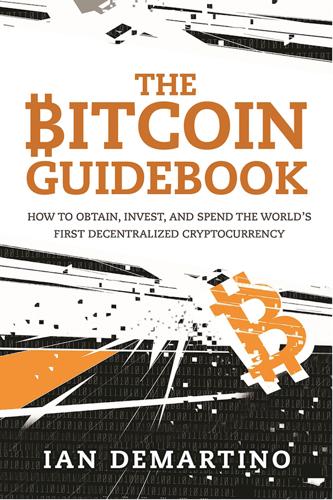
The Bitcoin Guidebook: How to Obtain, Invest, and Spend the World's First Decentralized Cryptocurrency
by
Ian Demartino
Published 2 Feb 2016
It is also accepted by a fair number of merchants, either through popular merchant processing companies such as Coin Merchants or independently on a merchant-by-merchant basis. Charlie Lee, who started Litecoin, was also an early investor in Coinbase, perhaps the most popular US-based on-ramp to Bitcoin. His involvement with Coinbase has led to near-constant speculation that Coinbase will accept Litecoin at some point. Given the status of Coinbase as a payment processor and a bridge to the fiat world, adoption by Coinbase would be extremely beneficial to Litecoin. Other than the Charlie Lee connection, however, there are currently no indications that Coinbase will ever accept Litecoin. From a technical standpoint, Litecoin is faster than Bitcoin. With the same block size as Bitcoin and a much shorter block time, the network is capable of performing more transactions per second than Bitcoin in its current form.
…
Dogecoin had gained a large overall market cap and with its hashrate quickly dropping, a 51% attack became a real possibility. The solution came by way of Litecoin. After much discussion in both communities, Litecoin decided to enable merged mining with Dogecoin. Despite the exceedingly small rewards available on the Dogecoin network, Litecoin miners still benefited from this decision. Since they use the same algorithm, both coins can be mined simultaneously without a decrease in mining of either.5 What this did was enable Dogecoin’s network to be secured by Litecoin’s miners, and anyone looking to force a double-spend through a 51% attack would have to match both the Litecoin network’s hashrate and that of Dogecoin.
…
With the same block size as Bitcoin and a much shorter block time, the network is capable of performing more transactions per second than Bitcoin in its current form. Bitcoin’s block size isn’t set in stone and there is an ongoing debate over changing the size of the blocks, but for now, Litecoin remains faster. Recently, Litecoin started merge mining (i.e., mining two coins with the same algorithm at the same time) with Dogecoin. Both coins use Scrypt, so hashrates can be put toward both coins simultaneously. There was no downside for Litecoin miners and the merge helped secure the Dogecoin network by bringing Litecoin miners onto it. Dogecoin Algorithm: Scrypt with AuxPoW Mining Type: Proof-of-Work Block Time: 1 minute Difficulty Re-target: Digishield (variable) Block Reward (current): 10k Doge Reward Curve: Halves every 840,000 blocks Total Number of Doge: 100 billion [goal, variable] If Litecoin is the most popular serious cryptocurrency, Dogecoin—pronounced either “Doggy Coin” or “Douje-Coin” depending on whom you ask—is the most “viral.”
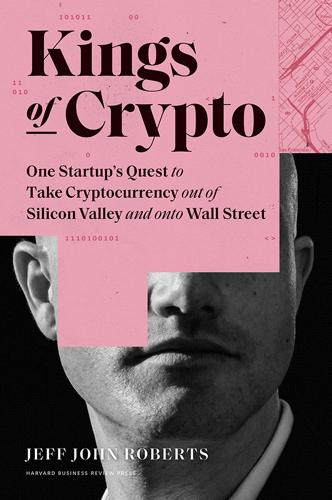
Kings of Crypto: One Startup's Quest to Take Cryptocurrency Out of Silicon Valley and Onto Wall Street
by
Jeff John Roberts
Published 15 Dec 2020
Charlie Lee, the company’s fifth employee, had a new home and a family who had grown tired of his long hours at Coinbase. Charlie also owned a hoard of Litecoin. He had created the lighter version of bitcoin while at Google in 2011, and the digital currency had since become worth billions, its value trailing only bitcoin and Ethereum. Litecoin’s value would soar still further, Charlie suspected, if more people could buy it. And the best way to make that happen would be to sell it on Coinbase. A popular story in crypto circles tells of Charlie secretly building Litecoin capacity into Coinbase’s code and, late one night, pushing the code live with no warning, only to be fired the next day.
…
A popular story in crypto circles tells of Charlie secretly building Litecoin capacity into Coinbase’s code and, late one night, pushing the code live with no warning, only to be fired the next day. It’s a good story, but it’s not true. A programming feat like adding Litecoin support to Coinbase would take a much longer time to build and numerous hours to launch. It can’t be done overnight. Also, Coinbase uses what employees call an “eye of Sauron” to ensure no one can unilaterally mess with its code without tripping alarms. Coinbase did launch Litecoin in the spring of 2017—with Brian’s full approval—and the price shot up 25 percent. The press pronounced the bounce was due to the “Coinbase effect,” a term that would create publicity, and trouble, for the company in the future.
…
CZ himself joined Brian and the Winklevoss twins as a crypto billionaire. A big reason for this success was another clever move by CZ: he decided Binance would eschew the business of trading conventional currency—dollars, euros, yen—for crypto and offer only crypto-to-crypto trades. This meant customers could swap bitcoin for Ethereum, or Ethereum for Litecoin, or Litecoin for dozens of other cryptocurrencies. For CZ, the crypto-to-crypto arrangement offered an obvious advantage: it meant Binance didn’t need to touch the conventional banking system, which was a landmine of laws and regulations. CZ also employed another tactic to avoid tangling with the Treasury Department and myriad other agencies in the United States and Europe: He based Binance in small island nations whose governments, eager for business, did not bother much with US-style banking rules.
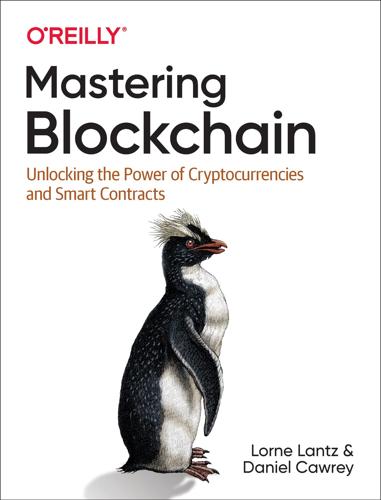
Mastering Blockchain: Unlocking the Power of Cryptocurrencies and Smart Contracts
by
Lorne Lantz
and
Daniel Cawrey
Published 8 Dec 2020
He also wanted to make his project “lite” so block times would be faster. Lee ultimately decided to give Litecoin four times the supply of coins of Bitcoin. In addition, the block time was set to be four times faster than Bitcoin’s. Lee also decided to not premine, and to use the (in 2011) ASIC-resistant Scrypt algorithm to attract hobbyists. (ASICs are used in numerous technical applications—they use a specialized chip design to perform one task very well. Scrypt is another proof-of-work algorithm, similar to Bitcoin’s SHA-256 with some different properties.) With Litecoin using Scrypt, people could mine both bitcoin and litecoin at the same time on their computers.
…
Prime numbers are used in encryption systems, and as computers become faster at calculations, larger prime numbers need to be discovered. Primecoin became known as the first cryptocurrency to have a proof-of-work with a use beyond just confirming transactions, with the work focusing on searching for chains of prime numbers. Litecoin The best-known altcoin from the early era is Litecoin. In 2011, Charlie Lee, a developer at Google, began spending time playing around with the Bitcoin code. He had observed that other projects had launched with interesting ideas but had continually failed to succeed, for various reasons. One factor Lee identified was that the developers of early projects often remained anonymous, like Satoshi Nakamoto, but unlike Satoshi, they didn’t introduce groundbreaking new concepts; they only tweaked the Bitcoin code.
…
With Litecoin using Scrypt, people could mine both bitcoin and litecoin at the same time on their computers. But eventually Scrypt would restrict bitcoin miners who wanted to use ASICs to profit from Litecoin because the algorithm was different. Developing Litecoin took Lee one week of planning and four hours of coding. It is still one of the top 10 cryptocurrencies by market capitalization. More Altcoin Experiments Lots more altcoins have been launched since the early era. A few interesting examples include: Dogecoin Invented by programmer Billy Markus and marketer Jackson Palmer in 2013, Dogecoin is the realization of an internet meme crossed with cryptocurrency. Tweeting as a joke (Figure 3-6), Palmer suggested creating a cryptocurrency based on the internet meme of a Shiba Inu dog (doge).
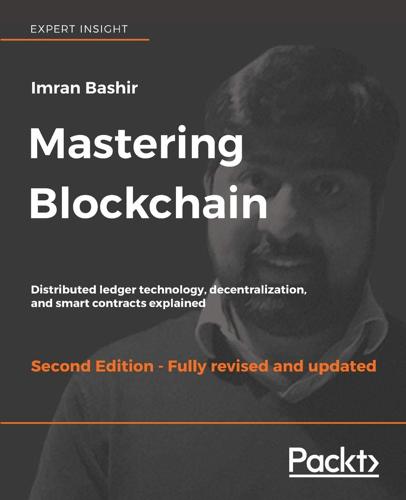
Mastering Blockchain, Second Edition
by
Imran Bashir
Published 28 Mar 2018
Scrypt ASIC design simplified flowchart Trading litecoin: As with other coins, trading litecoin is easily carried out on various online exchanges. The current market cap of litecoin is $10,448,974,615. The current price (as of March, 2018) of litecoin is $188.04/LTC. Mining: Litecoin mining can be carried out solo or in pools. At the moment, ASICs for Scrypt are available that are commonly used to mine Litecoin. Litecoin mining on a CPU is no longer profitable as is the case with many other digital currencies now. There are online cloud mining providers and ASIC miners available that can be used to mine Litecoin. Litecoin mining started from the CPU, progressed through GPU mining rigs, and eventually now has reached a point where specialized ASIC miners, such as ASIC Scrypt Miner Wolf are available from Ehsminer are now required to be used in the hope of being able to make some coins.
…
Generally, it is true that even with ASICs it is better to mine in pools instead of solo as solo mining is not as profitable as mining in pools due to the proportional rewards scheme used by mining pools. These miners are capable of producing a hashing rate of 2 Gh/s for Scrypt algorithms. Software source code and wallet: The source code for litecoin is available at https://github.com/litecoin-project/litecoin. The Litecoin wallet can be downloaded from https://litecoin.org/ and can be used just like the Bitcoin core client software. Primecoin Primecoin is the first digital currency on the market that introduced a useful PoW, as opposed to Bitcoin's SHA256-based PoW. Primecoin uses searching prime numbers as a PoW.
…
The name is entered and, after the Submit button is pressed, it will ask for configuration information such as DNS, IP, or identity: Namecoin wallet: domain name configuration As shown in the following screenshot, masteringblockchain will register as masteringblockchain.bit on the Namecoin blockchain: Namecoin wallet: showing registered name Litecoin Litecoin is a fork of the bitcoin source code released in 2011. It uses Scrypt as PoW, originally introduced in the Tenebrix coin. Litecoin allows for faster transactions as compared to bitcoin due to its faster block generation time of 2.5 minutes. Also, difficulty readjustment is achieved every 3.5 days roughly due to faster block generation time. The total coin supply is 84 million.

Blockchain: Blueprint for a New Economy
by
Melanie Swan
Published 22 Jan 2014
Layers in the technology stack of the Bitcoin blockchain Cryptocurrency: Bitcoin (BTC), Litecoin, Dogecoin Bitcoin protocol and client: Software programs that conduct transactions Bitcoin blockchain: Underlying decentralized ledger The key point is that these three layers are the general structure of any modern cryptocurrency: blockchain, protocol, and currency. Each coin is typically both a currency and a protocol, and it may have its own blockchain or may run on the Bitcoin blockchain. For example, the Litecoin currency runs on the Litecoin protocol, which runs on the Litecoin blockchain. (Litecoin is very slightly adapted from Bitcoin to improve on a few features.) A separate blockchain means that the coin has its own decentralized ledger (in the same structure and format as the Bitcoin blockchain ledger). Other protocols, such as Counterparty, have their own currency (XCP) and run on the Bitcoin blockchain (i.e., their transactions are registered in the Bitcoin blockchain ledger).
…
Then, the top layer is the currency itself, Bitcoin, which is denoted as BTC or Btc when traded in transactions or exchanges. There are hundreds of cryptocurrencies, of which Bitcoin is the first and largest. Others include Litecoin, Dogecoin, Ripple, NXT, and Peercoin; the major alt-currencies can be tracked at http://coinmarketcap.com/. Table 1-1. Layers in the technology stack of the Bitcoin blockchain Cryptocurrency: Bitcoin (BTC), Litecoin, Dogecoin Bitcoin protocol and client: Software programs that conduct transactions Bitcoin blockchain: Underlying decentralized ledger The key point is that these three layers are the general structure of any modern cryptocurrency: blockchain, protocol, and currency.
…
The concept and operational details are described in a concise and readable white paper, “Bitcoin: A Peer-to-Peer Electronic Cash System.”7 Payments using the decentralized virtual currency are recorded in a public ledger that is stored on many—potentially all—Bitcoin users’ computers, and continuously viewable on the Internet. Bitcoin is the first and largest decentralized cryptocurrency. There are hundreds of other “altcoin” (alternative coin) cryptocurrencies, like Litecoin and Dogecoin, but Bitcoin comprises 90 percent of the market capitalization of all cryptocurrencies and is the de facto standard. Bitcoin is pseudonymous (not anonymous) in the sense that public key addresses (27–32 alphanumeric character strings; similar in function to an email address) are used to send and receive Bitcoins and record transactions, as opposed to personally identifying information.

The Age of Cryptocurrency: How Bitcoin and Digital Money Are Challenging the Global Economic Order
by
Paul Vigna
and
Michael J. Casey
Published 27 Jan 2015
The result is that mining power remains somewhat more evenly spread and more democratic with litecoin. Miners still have an incentive to chase coin rewards, but the arms race and the electricity usage aren’t as intense. It also makes for faster turnarounds, with blocks completed within two and a half minutes, rather than bitcoin’s ten minutes, which in turn means the system’s wait for the final confirmation of transactions by customers and merchants isn’t as long. Litecoin’s main weakness is the corollary of its strength: because it’s cheaper to mine litecoins and because scrypt-based rigs can be used to mine other scrypt-based altcoins such as dogecoin, miners are less heavily invested in permanently working its blockchain.
…
Core bitcoin developer Jeff Garzik: See Daniel Cawrey, “Jeff Garzik Announces Partnership to Launch Bitcoin Satellites into Space,” CoinDesk, April 23, 2014, http://www.coindesk.com/jeff-garzik-announces-partnership-launch-bitcoin-satellites-space/; also see Catherine Bleish, “An Interview with Jeff Garzik, Bitcoin in Space,” Bitcoin Magazine, June 17, 2014, http://bitcoinmagazine.com/14069/interview-jeff-garzik-bitcoin-space/. Of these altcoins, litecoin: Litecoin explanations taken from various sources, including https://litecoin.org/. In the case of nextcoin: Nextcoin explanations taken from various sources, including http://nxt.org. “financial weapons of mass destruction,” as Warren Buffett called them: From 2002 Annual Report of Berkshire Hathaway Inc., edited excerpts, http://www.fintools.com/docs/Warren%20Buffet%20on%20Derivatives.pdf. 7.
…
Bitcoin has a big first-mover advantage over these new players, which is why many developers think the best solution is to fix its flaws rather than come up with entirely new systems. Nevertheless, the best altcoins are bringing an edgy and potentially constructive force of competition to bear in the whole cryptocurrency arena. Of these altcoins, litecoin, invented by Charlie Lee, is to date the most successful. Litecoin’s secret sauce is its use of a different algorithm in the hashing process that miners use to package transactions into the blockchain. Lee’s system still involves a competition among miners, but its hashing algorithm, known as scrypt, makes it easier for a miner to arrive at the sought-after block hash goal than does bitcoin’s SHA-256.

The Industries of the Future
by
Alec Ross
Published 2 Feb 2016
A British programmer decided to build his mine in Reykjanesbaer, Iceland, so his computers can run on geothermal and hydroelectric energy while being cooled by the arctic air. Litecoin markets itself as being more abundant and faster to mine than bitcoins. Charlie Lee, a former Google software engineer, designed Litecoin in his spare time and launched it in 2011 to complement Bitcoin. Lee said, “People like choices. You want to diversify your cryptocurrency investments.” He has described Litecoin as “silver to Bitcoin’s gold,” and he designed the Litecoin software to produce 84 million litecoins in comparison to Satoshi Nakamoto’s design for 21 million bitcoins. Lee also decided to use scrypt cryptography to reduce mining rates per unit down to 2.5 minutes in comparison to Bitcoin’s 10 minutes.
…
Charlie Lee, a former Google: Danny Bradbury, “Litecoin Founder Charles Lee on the Origins and Potential of the World’s Second Largest Cryptocurrency,” CoinDesk, July 23, 2013, http://www.coindesk.com/litecoin-founder-charles-lee-on-the-origins-and-potential-of-the-worlds-second-largest-cryptocurrency/. “People like choices”: Nathaniel Popper, “In Bitcoin’s Orbit: Rival Virtual Currencies Vie for Acceptance,” New York Times, November 24, 2013, http://dealbook.nytimes.com/2013/11/24/in-bitcoins-orbit-rival-virtual-currencies-vie-for-acceptance/. he designed the Litecoin: Robert McMillan, “Ex-Googler Gives the World a Better Bitcoin,” Wired, August 30, 2013, http://www.wired.com/2013/08/litecoin/.
…
he designed the Litecoin: Robert McMillan, “Ex-Googler Gives the World a Better Bitcoin,” Wired, August 30, 2013, http://www.wired.com/2013/08/litecoin/. Lee also chose this: “What Is the Difference between Litecoin and Bitcoin?” CoinDesk, April 2, 2014, http://www.coindesk.com/information/comparing-litecoin-bitcoin/. Ripple markets itself as: Ripple, https://ripple.com/. It has been compared to a hawala: “Hawala and Alternative Remittance Systems,” US Department of Treasury: Resource Center, http://www.treasury.gov/resource-center/terrorist-illicit-finance/Pages/Hawala-and-Alternatives.aspx; Antony Lewis, “Ripple Explained: Medieval Banking with a Digital Twist,” CoinDesk, May 11, 2014, http://www.coindesk.com/ripple-medieval-banking-digital-twist/.
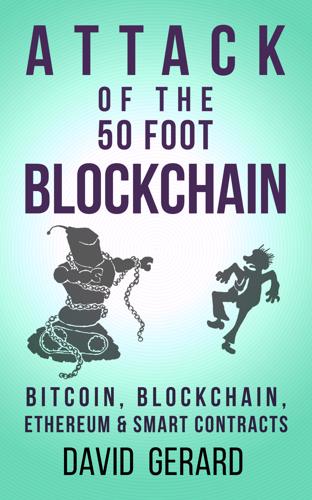
Attack of the 50 Foot Blockchain: Bitcoin, Blockchain, Ethereum & Smart Contracts
by
David Gerard
Published 23 Jul 2017
If you want to compare interest and activity in crypto assets, you need to compare trading volumes, if you can find good numbers for those. Litecoin Litecoin is the “me too” coin. It hasn’t many interesting stories, but it was the most prominent altcoin before the first Bitcoin bubble burst; for a few years, sites like the Pirate Bay that accepted Bitcoin donations often also accepted Litecoin donations. It was marketed as “the silver to Bitcoin’s gold.” The main difference from Bitcoin is a different hash designed to be resistant to GPU mining (though ASICs eventually came out) and a shorter block time. Litecoin’s price went up with Bitcoin’s until 2013, the price crashed with Bitcoin’s, and during 2014 it declined from its peak of $42 (spot prices of $68 on some exchanges) to $1.50.
…
Chapter 7: Spending bitcoins in 2017 Bitcoin is full: the transaction clog Bitcoin for drugs: welcome to the darknet Ransomware Non-illegal goods and services Case study: Individual Pubs Chapter 8: Trading bitcoins in 2017: the second crypto bubble How to get bitcoins From the first bubble to the second Bitfinex: the hack, the bank block and the second bubble Chapter 9: Altcoins Litecoin Dogecoin Ethereum Buterin’s quantum quest ICOs: magic beans and bubble machines Chapter 10: Smart contracts, stupid humans Dr. Strangelove, but on the blockchain So who wants smart contracts, anyway? Legal code is not computer code The oracle problem: garbage in, garbage out Immutability: make your mistakes unfixable Immutability: the enemy of good software engineering Ethereum smart contracts in practice The DAO: the steadfast iron will of unstoppable code Chapter 11: Business bafflegab, but on the Blockchain What can Blockchain do for me?
…
No, really: there are Bitcoin advocates who seriously look forward to economic collapse as an opportunity for Bitcoin – continued availability of high powered computing machinery, mining chip foundries, fast Internet and electricity presumably being absolutely assured in the grim meathook Mad Max petrolpunk future. (And we can use colloidal Litecoin for antibiotics.48) Even lesser crises get them all excited. Nick Szabo wrote up how to fix the Greek financial crisis of 2015 with Bitcoin.49 Someone responded to the Cyprus financial crisis of 2013 (which did include the much-feared government haircut of bank account deposits over the insured €100,000) with a house music anthem about “the blockchain.”50 You can use Bitcoin to buy drugs on the Internet!

Digital Gold: Bitcoin and the Inside Story of the Misfits and Millionaires Trying to Reinvent Money
by
Nathaniel Popper
Published 18 May 2015
Charlie Lee didn’t need to work another day of his life. Litecoin, his alternative cryptocurrency, which was a slightly faster, lightweight version of Bitcoin, had now become the second-most-popular cryptocurrency in what was becoming an increasingly crowded field of Bitcoin knockoffs. In part because of Charlie’s transparency in launching Litecoin, people trusted it and were betting that it would be, as Charlie had intended, the silver to Bitcoin’s gold. In November the value of all the outstanding Litecoins had briefly surpassed $1 billion. The particular computer chips that were good for mining Litecoins were sold out at nearly every online electronics retailer.
…
WHEN BOBBY LEE had first reached out to the founders of BTC China in February 2013, he was much less well known in the Bitcoin world than his younger brother, Charlie Lee, the California-based Google engineer who had been involved in Bitcoin since 2011 and who was perhaps best known as the creator of Litecoin, one of the most successful alternative virtual currencies. It was Charlie who had pushed Bobby, and the rest of his family, to first look at Bitcoin back in 2011. Bobby had a natural interest for the same reasons as his brother. The two men, who grew up sharing a bedroom, had both studied computer science, Charlie at MIT, Bobby at Stanford.
…
The particular computer chips that were good for mining Litecoins were sold out at nearly every online electronics retailer. Charlie had been mining Litecoins since the beginning, so he owned a sizable number of the coins, along with his significant Bitcoin holdings. His work at Coinbase was primarily due to his desire to help bring virtual currencies into the mainstream. Charlie saw that Bitcoin had done similarly good things for Bobby. Despite all the long hours and uncertainty Bobby had endured over the last few months, his position as a CEO, after years in middle management, had given him a confidence and self-assurance that seemed to outweigh the stresses of the job. Bobby had spent much of his time in the United States looking for new investors and partners for BTC China.
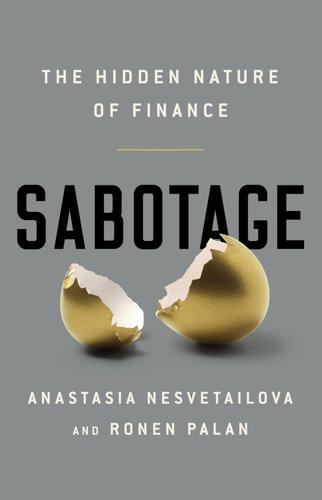
Sabotage: The Financial System's Nasty Business
by
Anastasia Nesvetailova
and
Ronen Palan
Published 28 Jan 2020
., ‘Fintech as a gateway for criminal enterprise’, Financial Times, ‘Alphaville’, 12 January 2018, https://ftalphaville.ft.com/2018/01/12/2197610/fintech-as-a-gateway-for-criminal-enterprise. Katz, L., ‘Criminals may ditch Bitcoin for Litecoin, Dash, study says’, Bloomberg, 8 February 2018, https://www.bloomberg.com/news/articles/2018-02-08/criminals-are-ditching-bitcoin-for-litecoin-and-dash-study-says. Kay, J., Other People’s Money: Masters of the Universe or Servants of the People?, Profile Books, 2015. Kelly, K., ‘EC will scour Bear trading data’, Wall Street Journal, 28 May 2008, www.wsj.com/articles/SB121193543321324769.
…
After its founder, Dread Pirate Roberts, or Ross Ulbricht, went down, it was succeeded by AlphaBay and many other dark marketplaces. Dread Pirate Roberts is now in prison serving a life sentence. The authorities still can’t get their hands on most of his bitcoins. 17. L. Katz, ‘Criminals may ditch bitcoin for Litecoin, Dash, study says’, Bloomberg, 8 February 2018, www.bloomberg.com/news/articles/2018-02-08/criminals-are-ditching-bitcoin-for-litecoin-and-dash-study-says. 18. Bateman, ‘Bitcoin might make tax havens obsolete’. 19. Ibid. 20. Conducted in January 2018. (Source: J. Wieczner, ‘Bitcoin investors aren’t paying their cryptocurrency taxes’, Fortune, 13 February 2018, http://fortune.com/2018/02/13/bitcoin-cryptocurrency-tax-taxes/). 21.
…
Petty crime, like selling medicine online or ghost-writing essays for inept students, also uses crypto for secrecy.16 Blockchain-based innovations have become the favourite method of payment in the criminal underworld. An Australian study estimated that about 47 per cent of transactions involving bitcoin are conducted on the darknet. Litecoin, the second-most-popular cryptocurrency preferred by Russians, is now accepted by nearly one-third of all dark-web vendors.17 The industry, of course, rejects any such claims. It gets worse. In a world where anyone can create money, crime groups have an interest in launching their own money transmission services and popularizing them as legitimate ‘fintech’ alternatives.
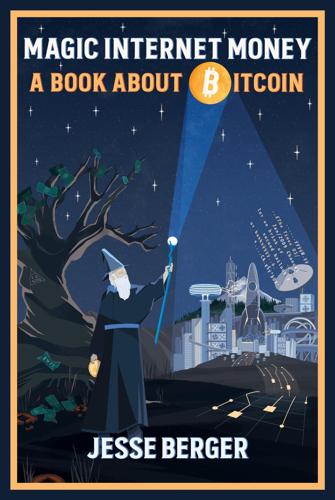
Magic Internet Money: A Book About Bitcoin
by
Jesse Berger
Published 14 Sep 2020
Saifedean Ammous, The Bitcoin Standard If blockchain is best understood as a tool for public collaboration, and if block rewards are the method by which participants are enticed to discover, expand, and utilize the network’s value, and if that value can be freely transferred, secured, and accounted for in a trust-minimized environment, then a well-designed blockchain invariably exhibits the attributes and functions of money. Since there is no other embodiment of value that can be both fully functional and fully verifiable as a purely digital entity, money necessarily rises to the fore as blockchain’s most compelling use. Many public blockchains such as Litecoin, Zcash, and Ethereum (more to come on these in Chapter 8) are attempting to funnel trust and value into their networks through the creative adaptation of blockchain principles, effectively testing the limits of its functionality, but none are more proficient than Bitcoin. Its value has grown faster than any other asset since its inception,10 and it is the most liquid of all blockchains.
…
Neumann, Computer Scientist “Crypto” is short for cryptography, but these days the term is more commonly known as a reference to the financial markets of blockchain-based digital assets. These are also sometimes referred to as “cryptocurrencies” or “cryptoassets.” There’s a wide array of initiatives in crypto, and their potential applications are limited only by the imaginations of their developers. Some of the more well-known examples include Litecoin,15 which aspired to be the silver to Bitcoin’s digital gold, and sometimes moonlights as a testnet for Bitcoin. There is Zcash,16 an enigmatic, privacy-focused currency that broadcasted its launch ceremony live on the Internet, and allots 20% of coin issuance to its founders. There is also Ethereum,17 which initially offered its coins as digital gas for fueling a world computer, and presently fuels a complex economy of digital tokens.
…
Chapter 7: Scarcity 13Andrew Glester, “The Asteroid Trillionaires” physicsworld (June 11, 2018). 14Nassim Nicholas Taleb, Antifragile: Things that Gain from Disorder (Random House, 2012). Chapter 8: Competition 15Litecoin (LTC) was released via open-source on GitHub on October 7, 2011, by Charlie Lee, a Google employee and former Engineering Director at Coinbase. The Litecoin network went live on October 13, 2011. 16Zcash (ZEC) was developed by Electric Coin Company (zcashd) and Zcash Foundation (zebra) on open source. It was initially released on October 28, 2016. 17Ethereum (ETH, also known as Ether) was proposed in late 2013 by Vitalik Buterin, a cryptocurrency researcher and programmer.

The Truth Machine: The Blockchain and the Future of Everything
by
Paul Vigna
and
Michael J. Casey
Published 27 Feb 2018
Every new idea will have shortcomings, yet, if developed by serious engineering teams, each idea can move the ball forward toward decentralization, functional governance, scalability, and privacy. This has been so with altcoins such as Litecoin, whose alternative approach to the proof-of-work algorithm showed that it was possible to stall the entrance of high-powered, industrial players into the mining network. Others—notably Vertcoin, discussed in chapter four—have improved on Litecoin’s model. Vertcoin has avoided Bitcoin’s unwelcome experience, in which the unrestrained competition for block rewards fostered a concentration of computation-heavy, electricity hungry mining operations.
…
This means that people running computers with relatively inexpensive graphic processing units, or GPUs, can successfully compete for a decent supply of coins and that a wider distribution of those tokens is possible. Eventually, chip designers tend to figure out how to make ASICs that overcome this resistance, as was the case with ASIC mining equipment that was specially designed to handle Litecoin’s s-crypt algorithm. But developers of Vertcoin have shown that it’s also possible to create a permanent commitment to ASIC-resistance by introducing something from the real, non-digital world of social organizations: a pact. If the platform’s governing principles include a pre-existing commitment from all users of the coin to accept a fork—a change to the code—that would add new, ASIC-resistant elements as soon as someone develops such a chip, the coin’s community can protect the distributed, democratic structure of a GPU-led mining network.
…
See also crowdfunding know-your-customer (KYC) know-your-machine Larimer, Daniel ledger-keeping and Bitcoin double-entry bookkeeping history of triple-entry bookkeeping value of Lehman Brothers Lemieux, Victoria L. Leondrino Exchange Lessig, Lawrence Levine, Matt Lewis, Michael Lightning Network Linux Foundation Litecoin Llanos, Juan Lloyd’s of London LO3 Energy Lovejoy, James Loyyal Lubin, Joseph Ludwin, Adam Lyft Lykke Madoff, Bernie Maidsafe Malaysian Airlines flight MH370 Marshall, George C. Marshall Plan Masters, Blythe May, Tim Mediachain MedRec Merkle Tree Metastable Capital Metz, Cade Micali, Silvio microfinance Microsoft Miller, Erick Miller, Mark S.
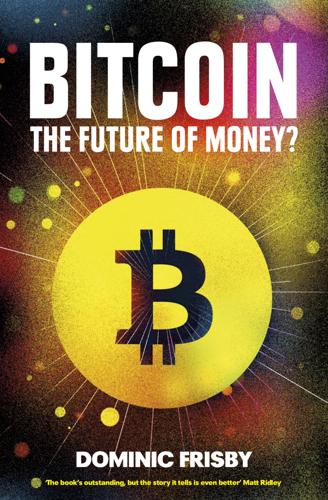
Bitcoin: The Future of Money?
by
Dominic Frisby
Published 1 Nov 2014
Nelson is an Asperger’s sufferer from Wrexham, who’s now worth millions. Olivier Janssens now flies from London to his new home in Monaco by private jet – paid for in bitcoins. On my hunt for amusing Bitcoin stories, one chap emailed me, saying: ‘I bought $8,000 worth of Litecoin at $2.30 back in June, and when Bitcoin skyrocketed to $1,240, Litecoin went to $52.00. I made $140,000, cashed out $70,000 and bought a new Range Rover. I now drive a Range Rover because of what people laugh at and call fake money.’ But with the failure of companies such as MtGox, you can bet there are many stories that are as disheartening as the above are amusing.
…
All the other altcoins combined amount to about $350,000. Bitcoin has attracted all the publicity. Bitcoin has all the infrastructure and investment. For now Bitcoin dominates the space. But the altcoins may one day come to rival Bitcoin. Litecoin is said to be silver to Bitcoin’s gold. It has faster transaction time confirmation than Bitcoin, making it a better system of payment. It also claims its storage efficiency is better. Like Litecoin, Dogecoin also has faster transaction time confirmation. It is a more inflationary system – there is no limit to supply and it has a faster coin production schedule. Its primary use has been for online tipping and fundraising – you see something you like, you give them some dogecoins.

Blockchain Revolution: How the Technology Behind Bitcoin Is Changing Money, Business, and the World
by
Don Tapscott
and
Alex Tapscott
Published 9 May 2016
See First era of the Internet Internet Engineering Task Force (IETF), 271, 281, 299, 305 Internet Governance Forum (IGF), 300 Internet of Things (IoT), 3, 38, 146, 147–48, 152–55 economic payoffs, 161–64 future developments, 164–67 hacking your future, 168–69 public sector use of, 206–7 twelve disruptions, 156–61 Internet Society, 281, 300 Intrade, 84 Investing, in financial services, 62–63, 64 IPOs (initial public offerings), 82–84, 127, 180, 181 Iran, 13 Ito, Joichi, 246–49, 286, 289, 301 Jaques, Elliot, 106 Jennings, Eric, 147–48, 157, 162–63, 260 Jensen, Michael, 100, 108 Jive, 139 Jobanputra, Jalak, 287 Job killer, 270–71 JPMorgan Chase, 8, 43, 63 Jumpstart Our Business Startups Act, 82–83 Jurisdiction issues, 264 Justice system, 220–21, 223 Kahn, Bob, 281 Kahneman, Daniel, 279 Kaminska, Izabella, 78, 257–58, 266 Karpeles, Mark, 247 Kaye, David, 244 Kaye, Max, 216 Keating, Zoë, 21, 235–36, 237 Kessler, Sarah, 135 Keyless signature infrastructure (KSI), 199 Kidder, Tracy, 150 Kim, Joyce, 170–72, 177, 287 Kirby, Peter, 194 Knowledge networks, 300–301 Kulin, Haluk, 43, 46, 48, 178 Kurzweil, Ray, 336n Labor markets, 270–71 Land title registration, 8, 19–20, 51, 188–89, 193–95, 198 Larsen, Chris, 59, 67 Law enforcement, 286–87 Law profession, 102–3 Lawsky, Benjamin, 8, 287, 289–92 Leadership, 24, 281–309 framework for governance, 298–307 new agenda for next digital age, 307–9 the players, 283–89 regulation and, 289–93, 296–97 Lederman, Leon, 4–5 Ledger of Everything, 152 Ledger of Things, 145–69 economic payoffs, 161–64 evolution of computing, 150–52 future developments, 164–67 hacking your future, 168–69 Internet of Things, 152–55 power to the people, 146–50 twelve disruptions, 156–61 Legal disputes, 100, 105, 193, 219, 221 Legal frameworks, 264 Legal recourse, lack of, 258 Lending value, in financial services, 62, 64 Libertarianism, 199–200, 201, 327n Library of Congress, 133 Licensed exchanges, 291 Lightfoot, Gordon, 29 Lighthouse, 94 Lih, Andrew, 131 Lincoln, Abraham, 199 LinkedIn, 99 Linux, 12, 88, 129–30, 141, 282 Linux Foundation, 69, 285 Lipset, Seymour Martin, 201 Liquid democracy, 218–19 Liquidity, 256, 295 Litecoin, 257 Litecoin Association, 267 Literacy, 172, 195, 249 Live Nation, 229 Living standards, 172 Locally generated power, 148, 149–50 London School of Economics, 74 LO3 Energy, 148, 149 Lubin, Joseph, 15–16, 88–91, 112–13, 141, 177–78 Ludwin, Adam, 68 Lundkvist, Christian, 76 Lyft, 134, 164 MaidSafe, 95 Mainframes, 150 Malaysia Airlines Flight MH370, 213 Managers (management) ConsenSys, 89–91 public sector, 206–7 smart devices and IoT, 157, 159–60, 161 Manifesto for the Digital Age, 308–9 Manila, remittances, 182–83, 186 Manufacturing, 160, 174 Marketing, search costs, 97 Massive open online courses (MOOCs), 248–49 Masters, Blythe, 8, 63, 65, 66, 68, 73, 287, 289 McAdam, Cindy, 287 McKinsey, 156, 163–64, 169, 194 McLuhan, Marshall, 14 McWaters, Jesse, 66, 306 Meckling, William, 100 Medical records, 158 Medici, 83 Member ownership, 89–91 Members of a social network, 262 Mesh networks, 123, 146–47 Metaverse, 38 Metering economy, 135–36, 180, 233 MHITs, 50–51 Microblogging, 246 Microfinance, 56, 170–72, 191–92 current issues with, 191–92 inclusion design principle, 49–51 Nicaragua example, 170–72, 176 prosperity passport, 177, 178 Microgrids, 148–50 Micromonetizing, 180–81, 233 Microsoft, 4, 150, 270, 310 Microsoft Yammer, 139–40 Millennials, 174 Mi.Mu, 228 Miners, 30–32, 240–41, 260, 267, 268–69 Mining, 240–41, 259–60, 268–69 Mining rate, 38 MintPal, 266 MIT Bitcoin Project, 247 MIT Digital Currency Initiative, 247, 282, 284, 286, 301, 303, 305 MIT Media Lab, 27, 246–47, 286, 305 M-of-N signature, 104 Monegraph, 133 Monetary policy, 37–38, 56, 294–95, 309 Money laundering, 176, 275–76 Monks, Robert, 78 Monopolies, 57, 93–95 Moore’s law, 4, 51, 307–8 Moreira, Carlos, 11, 14, 15, 154, 204 Morgan, Pamela, 219, 287 Mornini, Tom, 73–74, 77 Morris, Gilbert, 173 Motion detectors, 254 Moving value, in financial services, 61, 64 M-Pesa, 176 Mt.
…
Clippinger, CEO, ID3, Research Scientist, MIT Media Lab Bram Cohen, Creator, BitTorrent Amy Cortese, Journalist, Founder, Locavest J-F Courville, Chief Operating Officer, RBC Wealth Management Patrick Deegan, CTO, Personal BlackBox Primavera De Filippi, Permanent Researcher, CNRS and Faculty Associate at the Berkman Center for Internet and Society at Harvard Law School Hernando de Soto, President, Institute for Liberty and Democracy Peronet Despeignes, Special Ops, Augur Jacob Dienelt, Blockchain Architect and CFO, itBit and Factom Joel Dietz, Swarm Corp Helen Disney, (formerly) Bitcoin Foundation Adam Draper, CEO and Founder, Boost VC Timothy Cook Draper, Venture Capitalist; Founder, Draper Fisher Jurvetson Andrew Dudley, Founder and CEO, Earth Observation Joshua Fairfield, Professor of Law, Washington and Lee University Grant Fondo, Partner, Securities Litigation and White Collar Defense Group, Privacy and Data Security Practice, Goodwin Procter LLP Brian Forde, Former Senior Adviser, The White House; Director, Digital Currency, MIT Media Lab Mike Gault, CEO, Guardtime George Gilder, Founder and Partner, Gilder Technology Fund Geoff Gordon, CEO, Vogogo Vinay Gupta, Release Coordinator, Ethereum James Hazard, Founder, Common Accord Imogen Heap, Grammy-Winning Musician and Songwriter Mike Hearn, Former Google Engineer, Vinumeris/Lighthouse Austin Hill, Cofounder and Chief Instigator, Blockstream Toomas Hendrik Ilves, President of Estonia Joichi Ito, Director, MIT Media Lab Eric Jennings, Cofounder and CEO, Filament Izabella Kaminska, Financial Reporter, Financial Times Paul Kemp-Robertson, Cofounder and Editorial Director, Contagious Communications Andrew Keys, Consensus Systems Joyce Kim, Executive Director, Stellar Development Foundation Peter Kirby, CEO and Cofounder, Factom Joey Krug, Core Developer, Augur Haluk Kulin, CEO, Personal BlackBox Chris Larsen, CEO, Ripple Labs Benjamin Lawsky, Former Superintendent of Financial Services for the State of New York; CEO, The Lawsky Group Charlie Lee, Creator, CTO; Former Engineering Manager, Litecoin Matthew Leibowitz, Partner, Plaza Ventures Vinny Lingham, CEO, Gyft Juan Llanos, EVP of Strategic Partnerships and Chief Transparency Officer, Bitreserve.org Joseph Lubin, CEO, Consensus Systems Adam Ludwin, Founder, Chain.com Christian Lundkvist, Balanc3 David McKay, President and Chief Executive Officer, RBC Janna McManus, Global PR Director, BitFury Mickey McManus, Maya Institute Jesse McWaters, Financial Innovation Specialist, World Economic Forum Blythe Masters, CEO, Digital Asset Holdings Alistair Mitchell, Managing Partner, Generation Ventures Carlos Moreira, Founder, Chairman, and CEO, WISeKey Tom Mornini, Founder and Customer Advocate, Subledger Ethan Nadelmann, Executive Director, Drug Policy Alliance Adam Nanjee, Head of Fintech Cluster, MaRS Daniel Neis, CEO and Cofounder, KOINA Kelly Olson, New Business Initiative, Intel Steve Omohundro, President, Self-Aware Systems Jim Orlando, Managing Director, OMERS Ventures Lawrence Orsini, Cofounder and Principal, LO3 Energy Paul Pacifico, CEO, Featured Artists Coalition Jose Pagliery, Staff Reporter, CNNMoney Stephen Pair, Cofounder and CEO, BitPay Inc.
…
Ten minutes is also too long for financial transactions where timing matters to get an asset at a particular price, and where latency exposes traders to time-based arbitrage weaknesses such as market timing attacks.6 The immediate solution for entrepreneurs has been to fork the bitcoin code base, that is, to modify the source code by tweaking a few parameters, and to launch a new blockchain with an altcoin in place of bitcoin as incentive to participate. Litecoin is a popular altcoin with a block time of 2.5 minutes, and Ripple and Ethereum are entirely reengineered blockchain platforms that have latency of seconds, not minutes. A sixth dimension is behavioral change in a deeper sense than Netiquette. Today, many people count on their bank or credit card company, even talking with a real person, when they make an accounting error, forget their passwords, or lose their wallets or checkbooks.

Silk Road
by
Eileen Ormsby
Published 1 Nov 2014
Instead of bitcoin, Atlantis initially accepted only litecoin, a new form of cryptocurrency. It was odd that the site didn’t accept bitcoin, which by now had become widely used not only on the black markets but increasingly for legitimate purposes. Small retailers, online stores, activist groups and charities were all hopping on board to accept bitcoin for payment for their goods and services and for donations. The decision to accept only litecoin led to some speculation that Atlantis had a vested interest in the alternative cryptocurrency. One of the founders fuelled that suspicion when they said, ‘Litecoin has a much smaller market share than bitcoin, so we needed to do something drastic to bring attention to the currency and to Atlantis as a way of jump starting the community.’

Bit by Bit: How P2P Is Freeing the World
by
Jeffrey Tucker
Published 7 Jan 2015
What we can do now is be careful not to trust any institution fully. Security for your property is at a premium until the market shakes itself out. Question: What is Dogecoin? Tell me about it. Answer: It’s very cool, or maybe it is a silly fad. The market has to decide. Dogecoin is one of many currencies built on a Litecoin protocol, which in turn was built on bitcoin. There are tens of thousands of so-called altcoins in circulation today. This is market competition at work. They all live in their own ecosphere. May the best coin win! Question: How does the U.S. government classify BTC? Answer: The Treasury Department says bitcoin is property subject to taxation.
…
There are serious risks to such altcoins and it will be some time before the altcoin market becomes stable and reasonably disciplined by market forces. This is part of what happens in any startup technology. Question: Can you tell me about one or two popular altcoins? How are they different? Will they replace bitcoin? Answer: Litecoin is the second most popular cryptocurrency. It is based on a different algorithm from bitcoin, and it has an infinite inflation rate. Others include Namecoin, Dogecoin, Worldcoin, Peercoin, Primecoin, and Feathercoin. All have unique properties and some appeal to people for specific reasons. The Indian nation of Lakota, for example, uses its own coin called Mazacoin. 41 The cryptocurrency market is still in its infancy.
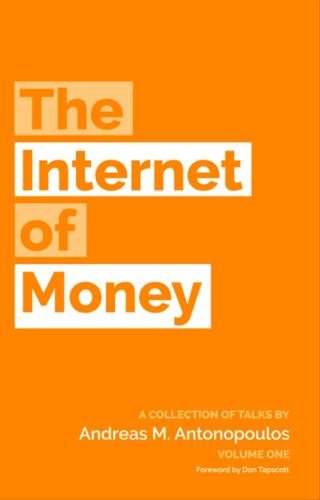
The Internet of Money
by
Andreas M. Antonopoulos
Published 28 Aug 2016
We’re probably going to see meta-currencies whose only purpose is to aggregate the value in all of our wallets for all of our currencies, and allow us to understand value as an abstraction that exists independently of the currencies in which it’s expressed. 7.6. Choosing Currencies and Communities So, that’s a slightly philosophical perspective. That’s why I think it doesn’t matter: Ether is not competing with bitcoin; bitcoin is not competing with Litecoin. They are all means to express the transactional modality we want to use at any point in time to achieve our goals. With this comes a very important and powerful tool. In the choices we make with these currencies, we are also choosing to align ourselves with a community. "Adoption is not simply the act of using the currency; it’s also attaching oneself to a community that has also chosen to adopt that currency."
…
Dumb Networks E economic activities, Primates and Money economic inclusion, Communications Expanding While Access to Banking Is Declining economics, Tragedy of the Commons electricity, Infrastructure for Natural Gas, From Natural Gas to Electricity elements, Bitcoin’s Atomic Structure email, Multiple Currencies Coexist, Alt Groups Will Destroy the Internet email attachments, Email and Email Attachments Will Destroy the Internet Ether, Choosing Currencies and Communities ethereum, Currency as a Language evolution, Currencies Evolve expression, Currency as a Means of Expression F fees, Bitcoin, the Invention, There Are No Spam Transactions in Bitcoin, Open Innovation and Opt-In Systems, Fee Optimization and Scaling, Spam Transactions, Legitimate Transactions, Illegitimate Transactions festival, Festival of the Commons festival of the commons, Dumb Networks, Innovation, and the Festival of the Commons financial exclusion, Dreaming of Totalitarian Control over All Financial Transactions financial inclusion, Predicting the Future for consumers, Open Innovation and Opt-In Systems freedom, Communications Expanding While Access to Banking Is Declining, Censorship of Financial Transactions, Bitcoin, the Zombie of Currencies, Banking Privilege and Surveillance G game theory, Open Innovation and Opt-In Systems geopolitics, Communications Expanding While Access to Banking Is Declining global, Money of the People, Solving Payment Problems global culture, Communications Expanding While Access to Banking Is Declining grand arc, Grand Arc of Technology H HD wallets, Festival of the Commons 2012-2014 hierarchy, Banking: Liberator to Limiter honeypot, Attacks Build Resistance I identity, Dreaming of Totalitarian Control over All Financial Transactions, Banking Privilege and Surveillance incentives, Open Innovation and Opt-In Systems inclusion, Money of the People, Banks for Everyone, Including 6.5 Billion People in a Global Economy, Banking Privilege and Surveillance incremental tech, Designing for Innovation index, Index Currency infrastructure inversion, Infrastructure Inversion, From Horses to Vehicles banking, From Banking to Bitcoin data, From Voice to Data electricity, From Natural Gas to Electricity paved roads, From Horses to Vehicles innovation, Recognizing Innovation, Open Innovation and Opt-In Systemsadoption, Infrastructure for Natural Gas asking permission, New Architecture, New Access automobiles, The Dangers of Automobiles, Electricity, and Bitcoin, New Technologies, Riding on Old Infrastructure banking, New Architecture, New Access, Open Innovation and Opt-In Systems, Festival of the Commons, Banking Privilege and Surveillance byob (be your own bank), Including 6.5 Billion People in a Global Economy cameras, Incumbent Reactions to Innovation competition, Infrastructure for Human Voices creativity, Building Blocks of Lego credit cards, Paper to Plastic crime, The Dangers of Automobiles, Electricity, and Bitcoin criticism, The Dangers of Automobiles, Electricity, and Bitcoin criticisms, Infrastructure for Horses, Infrastructure for Natural Gas disruptive tech, Designing for Innovation economic activities, Primates and Money electricity, Infrastructure for Natural Gas for consumers, Open Innovation and Opt-In Systems HD wallets, Festival of the Commons 2012-2014 incremental tech, Designing for Innovation infrastructure inversion, From Horses to Vehicles internet, UX and Society interstitial, Interstitial Innovation investment, Festival of the Commons 2012-2014 Linux, Incumbent Reactions to Innovation makers, Recognizing Innovation mash-up, Interstitial Innovation media, Infrastructure for Natural Gas modem, Infrastructure for Human Voices MP3, Incumbent Reactions to Innovation multisignature, Festival of the Commons 2012-2014 new medium, Separating the Medium and the Message open, Incumbent Reactions to Innovation paper money, Precious Metals to Paper permission, The Smart Network - Phones permissionless, Neutrality, Criminals, and Bitcoin, New Architecture, New Access, Bitcoin’s Dumb Network regulation, Predicting the Future tools for, Building Blocks of Creativity wallet, Fee Optimization and Scaling international finance, Money of the Peopleinternet, Bitcoin, the Invention, Neutrality, Criminals, and Bitcoin, New Architecture, New Access, The Dumb Network - Internet, UX and Society, Usenet Will Destroy the Internetprinting press, Authority by Production interstitial, Interstitial Innovationinvestment, Festival of the Commons 2012-2014 K keys, Master-Slave Architecture, Wallets aren’t wallets permission, Wallets aren’t wallets L language, How Old Is Money? lightning network, Building Blocks of Bitcoin Linux, Incumbent Reactions to Innovation Litecoin, Choosing Currencies and Communities M makers, Recognizing Innovation mash-up, Interstitial Innovation master-slave architecture, Master-Slave Architecture media, Infrastructure for Natural Gas medium message, Separating the Medium and the Message message, Separating the Medium and the Messagemeta-currencies, Index Currencymeta-instrument, Index Currencymeta-politics, Choosing Currencies and Communitiesmetaphors, Bitcoin and Designmicropayments, Solving Payment Problemsmicrotransactions, Solving Payment Problemsmodem, Infrastructure for Human Voicesmoney, Born into Currency, Valuing Currencies by Useabstract value, Barter to Precious Metals age of, How Old Is Money?
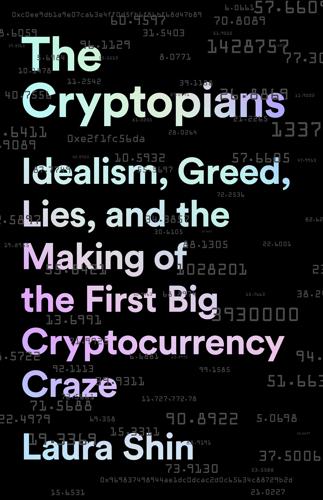
The Cryptopians: Idealism, Greed, Lies, and the Making of the First Big Cryptocurrency Craze
by
Laura Shin
Published 22 Feb 2022
He was fascinated by how Namecoin was a coin for censorship-resistant domain registration, and Primecoin was a system for discovering prime numbers. He began buying alt-coins like Litecoin, Namecoin, Peercoin, Feathercoin, Terracoin, and so forth, but lived off his savings from the appreciation of gold, his chemical engineering earnings, and his unemployment checks. At one point, when he was in Los Angeles doing Thai massage, Litecoin went from $2 to $40, netting him $17,000. That was a year of living expenses! During a short-lived stint trying to become “the Bitcoin guy for Ecuador,” he completed a master’s in digital currency from the University of Nicosia and wrote his thesis on a bike-sharing economy that functioned via decentralized autonomous corporations.
…
Shortly after that, it was at $2—almost four times its value of $0.58 in late September, when Vitalik told the community that, at that price, the foundation might have to close in nine months. Not only did the foundation have much more money than before, but $2 ETH made Ethereum the third most valuable blockchain, surpassing Litecoin, known as the silver to Bitcoin’s gold. At this point, some developers who had been let go were offered positions to return to the foundation (though not Gav). A new C++ hire, an Englishman living in Canada named Bob Summerwill, who joined in February, had actually been working for free since launch the previous summer.
…
In twelve months, the tiny website started by two best friends as a side project had grown to seventy-seven times its original size. DURING THIS TIME Vitalik was in Asia, doing events in Taiwan and then going on a Christmas vacation/company retreat in Phuket, Thailand, with Virgil, Aya, researchers, and other friends at the sublime, oceanfront Samira Villa, partly owned by another friend in attendance: a bitcoin, litecoin, and ether mining pool operator named Chun Wang of F2pool. The “hillside estate,” as the website described it, was one of the sumptuous, sun-filled, high-ceilinged gems on Millionaires’ Mile, replete with an infinity pool, a Jacuzzi, rain showers, a fire pit, a game room, and a multitude of views of the cerulean and turquoise ocean, with water so transparent that, from the house, one could see underwater reefs.
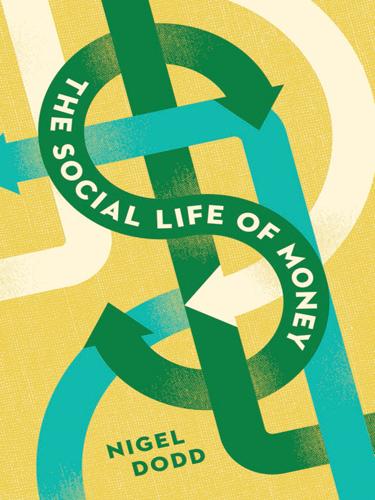
The Social Life of Money
by
Nigel Dodd
Published 14 May 2014
Some 36.7 percent of users do not drink, smoke, gamble, or take drugs, and more people have used Bitcoin for donations than for illegal transactions (see http://simulacrum.cc/2013/04/13/overview-of-bitcoin-community-survey-feb-mar-2013/). 39 Quoted in “The Bitcoin Boom,” The New Yorker, April 2, 2013, see http://www.newyorker.com/online/blogs/elements/2013/04/the-future-of-bitcoin.html. 40 There are several other alternatives to Bitcoin, such as Litecoin, Namecoin, PPCoin, and Dogecoin. As of January 2013, there were more than seventy digital currencies listed on http://coinmarketcap.com/. Each offers its own distinct variation on (and reputed advantage over) the Bitcoin theme. For example, Litecoin can be mined using consumer-grade hardware (see https://litecoin.org/), while PPCoin is designed to be more secure (see https://en.bitcoin.it/wiki/PPCoin). Dogecoin, using the Shiba Inu dog as its mascot, is based on Litecoin. In 2014, a new digital currency called Coinye West—the name is inspired by the rapper, Kanye West, although he has no direct links with the project—was due to be launched, reputedly for use in the music industry. 41 See http://freico.in/faq/. 42 For example, “For the 99% who live paycheck-to-paycheck, the loss from demurrage is minimal and would be compensated for in wages and pricing.
…
See also time banks; time dollars labor movement, 75 labor theory of value, 344 Lacan, Jacques, 40–41, 172n LaGuerre, Michel, 303 Landsberg, Paul-Louis, 172n language, economy of, 36; in Fromm, 332; and god, 35; as metaphor; 35–36; and money, 35–36, 37–38, 40, 47, 180, 185, 190; and referentiality, 77; and the social bond, 39 Lapavitsas, Costas, 78n Latour, Bruno, 292 Laum, Bernhard, 20n8, 25, 45, 112 law, 4, 17 Lazzarato, Maurizio, 160n8, 231n25 Lee, Benjamin, 62 Lehman Brothers, 1, 49, 50, 114, 116, 220 Leiris, Michel, 168, 172n leisure, 155 leisure class, 151 Lenin, Vladimir, 11, 51, 60, 66, 68; on Hilferding, 61; on money versus finance, 61 Leontief, Wassily, 117 leverage, 114, 116, 119–20 Lévi-Strauss, Claude, 172n Lewitzky, Anatole, 172n libertarianism, 21, 26, 72n, 105, 199, 293, 315n, 331, 360, 369n, 381, 382 LIBOR affair, 120 Lichtenberg, Georg Christoph, 145 Linden dollars, 292 Linton, Michael, 85 Linux Foundation, 369 LiPuma, Edward, 62, 296 liquidity, 4, 52n8, 116, 131n57, 264n, 287 liquidity crisis, 52n8 liquidity guarantee program, 127–28 liquidity premium, 125, 347, 348, 349 liquidity risk, 124 Lisbon Treaty, 265 Litecoin, 370n40 living currency, 203–4, 233, 342 local currency, 14, 105, 214, 286, 292, 293, 294, 315, 325, 360, 373; limited purpose nature of, 373 local exchange trading scheme (LETS), 84–87, 293, 316, 344, 345, 350, 360, 376, 381; and barter, 85, 86; defined, 84–85; origins of, 84 local trade, 325 Locke, John, 151, 219 logical positivism, 36n “Lord Keynes,” 368 Lotringer, Sylvère, 227 Louis XIV, 321 Lukács, György, 275n Luxemburg, Rosa, 11, 51, 64–65, 66, 67; on accumulation, 65, 68 luxury, 13 Lyotard, Jean-François, 39 Maastricht Treaty, 206n37, 253, 255, 263; convergence criteria, 253–54, 263–64 Mabile, Pierre, 172n Machiavelli, Niccolò, 246 MacKenzie, Donald, 200 Madoff, Bernard, 198 Magee, Bryan, 36n Malinowski, Bronislaw, 31, 32, 33 Malthus, Thomas, 65 mana, 31, 195; relationship to currency, 33 Mandeville, Bernard, Fable of the Bees, 347 Mann, Thomas, 247 Marazzi, Christian, 11, 72–78, 240–41, 246, 249; on bare life, 249–50, 266–67; on cognitive capitalism, 76; on finance, 249–50; on monetary terrorism, 75 Marcuse, Herbert, 149 marginal utility, 29 markets, 16; authority of, 220; as an axiomatic, 232; in Baudrillard, 196; and colonialism, 60; in food, 3; in Hardt and Negri, 241, 243–34; internal versus external, 65; and monetary governance, 21; and the origins of money, 18–19, 23, 24, 44, 95; in Polanyi, 279–81; and scarcity, 196; versus states, 247, 306–7; and symbolic exchange, 196 Marlowe, Christopher, 92 Marshall, Alfred, 276 Marshall, George, 206 Marshall Plan, 166, 206–7 Marx, Karl, 13, 66, 211, 213, 232, 238, 240, 271, 275, 276, 291, 295, 311, 332, 334, 351; on alienation, 273–74, 341; on banks, 50, 55, 56; on banknotes, 55; on barter, 53;Capital, 39, 49, 51, 56, 62, 63, 67, 80, 83, 147n, 236, 295, 361, 391; on capitalism, 59–60; on cash, 52, 54, 57, 58–59, 62, 66; The Communist Manifesto, 181; on compound interest, 147n; on the contradictions of capitalism, 72, 83; on the contradictions of money, 50, 51–55, 57, 61, 63, 71, 75, 80, 87, 273, 344, 347–48, 390; and credit crisis, 88, 133; on credit inflation, 56–57, 58, 61; on credit money versus the monetary base, 78–79; “The Critique of the Gotha Programme,” 84; on dead labor, 337; definition of money, 8, 11–12, 51n; on the destruction of capitalism, 146; The Economic and Philosophic Manuscripts of 1844, 56n, 181n8, 295, 334; on fictitious capital, 57n16; and the financial crisis, 49–51; on the functions of money, 51–52; on gold, 53, 58–59, 62–63, 79, 151; Grundrisse, 39n36, 51, 64, 80, 250, 273, 274, 344, 351; on hoarding, 52, 53–54, 58, 61, 67, 181, 274, 348; on labor money, 344–45; on the law of value, 61; and LETS, 85, 87; on money of account, 51n, 54; on money as fetish, 62; on the money form, 39, 51n, 52; on money and language, 34, 39n36; “On James Mill,” 273; On the Jewish Question, 274; on the origins of money, 52–53; The Poverty of Philosophy, 51, 53; on primitive accumulation, 63–66, 67, 98, 148, 222; on Proudhon, 53, 72, 84; on public debt, 147–48, 154; on religion, 340; on Ricardo, 59; and Simmel, 137; on Smith, 63 Masson, André, 169 MasterCard, 377, 380n mature money economy, 27, 137, 322, 330 Maurer, Bill, 8, 35, 296, 297, 378n50 Mauss, Marcel, 164, 198, 200, 267; and Bataille, 165; and Derrida, 165; The Gift, 31, 32, 167, 168, 195; on gift exchange, 31–34, 183, 188; on money, 32, 170; on the origins of money, 32–33; on religion, 167; on sacrifice, 167; Sacrifice: Its Nature and Function (with Hubert), 167; on sociology, 168 May, Timothy, 363 Mayer, Hans, 172n McCloskey, Deirdre, 38n34 McCulley, Paul, 119n39 McLuhan, Marshall, 194, 195 Mead, George Herbert, 319 measurement, 18, 24, 25, 28–29, 37, 39, 103n14, 112, 174, 194, 259, 274, 297, 302–3, 325, 343, 344, 345, 390; of culture, 138; of honor, 97; of humans, 97; of labor, 70; of money and time, 145; of moral worth, 91; of the quantity of money, 122n, 213; of value, 51, 52n8, 70, 71; of wealth, 71 Meltzer, Françoise, 184 memory bank, 308–9 Mencken, Henry Louis, 343n13 Menger, Carl, 17–23, 25, 26, 45, 47, 105n17, 236, 359, 362; definition of money, 18n5; and Simmel, 137 mental accounting, 290–91 Mephistopheles, 92 mercantilism, 66 Merrill Lynch, 114, 221 Mesopotamia, 95 Messianic time, 335, 338 metallism, 102, 383 Methodenstreit, 285 metropolis, 250 microcredit, 357–58 Midas, 153 migrant workers, 293 migration, 226, 240, 263, 293, 305 mimesis, 43–45; and financial panic, 77 minimum wage, 325, 382 Minsky, Hyman, 50, 58, 66, 108, 117–21, 124; on securitization, 120–21.
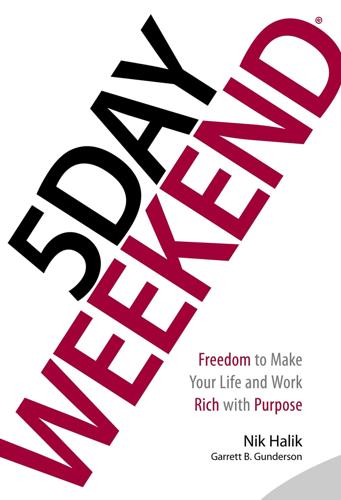
5 Day Weekend: Freedom to Make Your Life and Work Rich With Purpose
by
Nik Halik
and
Garrett B. Gunderson
Published 5 Mar 2018
Cryptocurrencies make it easier to transfer funds between two parties in a transaction, and with minimal processing fees compared to the steep fees charged by most financial institutions. The adoption rate of cryptocurrencies is increasing daily with banks, corporations, and governments recognizing its mainstream popularity. The current leading cryptocurrencies are Bitcoin, Ethereum, Litecoin, Monero, Dash, and Ripple. A popular way to buy and sell cryptocurrencies and create your own digital currency “wallet” is to use a platform like Coinbase.com or Bittrex.com. Speculative investors should be aware there are risks involved in the investment and use of cryptocurrencies, such as fraud and security of the platforms.
…
Keohohou, Nicki Kets de Vries, Manfred keystone habits Kiyosaki, Robert Komisar, Randy Kroc, Ray L labor markets, technology’s transformation of Lavie, Peretz Lemony Snicket Lending Club leverage, and Cash Flow Insurance and content and creating greater returns and credit scores and current assets and entrepreneurship and real estate investments liabilities, and insurance vs. debt liberated entrepreneurs life boards, creating life insurance, combining with long-term care insurance as protective expense whole life insurance lifestyle, and cash flow cutting expenses of and freedom and Growth investment strategies and loan debt Linchpin (Godin) LinkedIn liquidity, and Cash Flow Insurance of checking and savings accounts and economic cycles and failure of conventional investments of Growth investments and real estate investments and reducing debt and tax lien certificates Litecoin “Live Like You Were Dying” (song) Living Wealthy Accounts LLCs loads, on mutual funds loans, and Cash Flow Index and credit scores and economic cycles for real estate investments restructuring from retirement plans against whole life insurance policies See also debt location, and real estate investments and storage unit construction Loehr, Jim long-term care insurance Loopnet Lyft, as entrepreneurial opportunity Lynch, Peter M Mackay, Harvey “mailbox money” myth maintenance, and storage units Mandela, Nelson Marcus Aurelius market conditions, and business startup investments and real estate investments market cycles See also economic cycles market demand, and entrepreneurial opportunities Mastermind Principle materialism, and the American dream and simplicity Maxwell, John McCain, John McCoy, Dan meals, as tax deduction meaning, and generosity medical insurance, as protective expense Melish, Stephanie mental capital mental energy mentors, and building your inner circle microcredit Mill, John Stuart mindfulness mindset, of abundance changing components of a strong and control and debt and hiring employees and limitations and Living Wealthy Accounts and quitting your job and real estate investments and resourcefulness strengthening mineral rights mobile apps, as entrepreneurial opportunity Moffat, Kyle Momentum investments, and active vs. passive income streams business startups cryptocurrencies description of gold and silver speculation and Growth investment strategies investing in people and Passive Income Ratio private equity investments purchasing distressed businesses understanding financial reports Monero monetary policies, and economic cycles moneylenders money managers fees money mastery Moody, D.

Cloudmoney: Cash, Cards, Crypto, and the War for Our Wallets
by
Brett Scott
Published 4 Jul 2022
The imagery of rugged heroic individualism alongside trading is enticing to men who might otherwise be working a standard day job. Launching digital collectibles that tap into this can be very lucrative, which means the factionalism is now as much commercial as it is political. Since Bitcoin, hundreds of ‘alt-coins’ have emerged, Bitcoin-like clones with new branding. These tokens – such as Litecoin, Peercoin or Dogecoin – maintain the same basic collectibles structure by issuing a limited edition set of numbered tokens, but tinker with their logo, quantity, mechanism or privacy. Cyberspace is now littered with countless crypto-tokens sold in exchange for US dollars. Many of these first-wave systems should be seen as proof-of-concept initiatives (albeit ones that enabled their promoters to become extremely wealthy), but they have paved the way for more sophisticated iterations, to which we will now turn.
…
Morgan, 8, 96, 150, 156, 227, 232 Jamaica, 42 Japan, 18, 35, 135, 215, 248 Johannesburg, South Africa, 129 Johnson, Alexander Boris, 38 Kazakhstan, 11, 227–9, 233, 247 Keep Cash UK, 262 Kelly, Kevin, 12 Kentridge, William, 144 Kenya, 47, 75, 129, 130–31, 169, 178, 179 Kerouac, Jack, 173, 175 Keynesianism, 80 ‘Kindness is Cashless’, 40 Kiva, 238 Kowloon Walled City, Hong Kong, 216, 219, 220, 226 Kuala Lumpur, Malaysia, 60, 74 Kurzweil, Ray, 153, 252–3 Kyoto, Japan, 135 La Guardia Airport, New York, 128 learning methodology, 163–4 left-wing politics, 7, 184, 191, 211–12, 215 Lehman Brothers, 17–18 Lenddo, 169 Level 39, Canary Wharf, 17, 20, 27, 41, 143 Leviathan (Hobbes), 177 leviathans, 177–84, 215–16 libertarianism, 7, 14, 42, 155, 156, 184 cryptocurrency and, 191, 212, 215–16, 225–6 Libra, 236–41, 245 Litecoin, 218 Lloyds, 72–3, 144, 146 loans, 70–71, 107, 159 artificial intelligence and, 167–8, 172 London, England, 128, 247, 248 Brixton Market, 177 Camberwell, 128 Canary Wharf, 17–18, 20, 41, 62, 211 City of London, 6, 135 Mayor’s Fund, 38 Somali diaspora, 116, 179 Stock Exchange, 24 Underground, 11, 37–8, 86, 87 longevity derivatives, 160 Lonsdale, Joe, 155 Lord of the Rings, The (Tolkien), 19, 155 Los Angeles, California, 101 Luther, Martin, 212 M-Pesa, 79, 109 machine-learning systems, 163–4 Macon, USS, 153 Mafia, 163 Main Incubator, 143 Malaysia, 7, 45, 60, 74 Malick, Badal, 127–8 malware, 32 manifest destiny, 212 ‘Manifesto for Cashlessness’ (Emili), 37 Maputo, Mozambique, 96 Marcus, David, 237, 241 Maréchal, Nathalie, 113 marijuana industry, 101–3 market price, 29, 171 markets, 65, 124–6, 176–80 choice and, 124–6 giant parable, 54 informal, 176–9 oligopolies and, 124–5 payments companies and, 29, 30, 31, 32–3 Marxism, 155, 262 Massachusetts, United States, 46 Massachusetts Institute of Technology (MIT), 7 Mastercard, 30, 37, 39, 77, 91 automatic payments, 149 data, 109, 111 financial inclusion and, 131–2 Wikileaks blockade, 116 Masters, Blythe, 232 Matrix, The (1999 film), 226 Mayfair, London, 6 McDonald’s, 145, 153 Medici family, 135 Melanesia, 255–6 Mercy Corps, 131, 132 Mexico, 42 Microsoft, 7 Azure cloud, 233 Word, 32, 156 middle class, 86, 128, 129 Mighty Ducks, The (1992 film), 234 Military Spouse, 153 millennials, 86, 140 Minority Report (2002 film), 10 mis-categorisations, 167 mist, 30–33 MIT Media Lab, 7 Modi, Narendra, 43, 93 Moffett airfield, California, 153 Monetarism, 80 money creation, 59–63, 67–72, 202 Money Heist (2017 series), 61 money laundering, 42, 116 money users vs. issuers, 50–52 money-passers, 30, 32–3 Monzo, 113, 142 Moon Express Inc., 153 mortgages, 26–7, 94 motor cortex, 248 Mountain View, Silicon Valley, 153 Moynihan, Brian, 38 Mr Robot, 184 Mubarak, Hosni, 116 Mugabe, Robert, 239–41 Mumbai, India, 96 Musk, Elon, 15, 212, 257 mutual credit systems, 259–60 N26, 142 Nairobi, Kenya, 129, 179 Nakamoto, Satoshi, 13, 184–5, 187, 191, 204 NASDAQ, 157, 233 National Aeronautics and Space Administration (NASA), 153 National Arts Festival, 144 National Retail Federation, 86 National Security Agency (NSA), 112, 155 Nationwide, 145–6 Natural Language Processing (NLP), 146 natural market order, 192 Nazarbayev, Nursultan, 227 Neener Analytics, 169 neo-Nazism, 226 nervous system, 20–22, 57, 80, 81, 240, 247–8, 251–2 Nestlé, 24, 28 Netflix, 61 Netherlands, 48, 49, 128–9 Nets Union Clearing Corp, 115 Network Computing, 78 New Age spiritualism, 7, 14, 193, 226 New Jersey, United States, 46 New Scientist, 137 New World Order, 261 New York City, New York, 18, 91–2, 128, 248 La Guardia Airport, 128 Wall Street, 6, 178–9 Nigeria, 43 No Cash Day, 37 no-file clients, 169 Nobel Prize, 93 nomadism, 228 non-seepage, 73 Norway, 35 nudging, 39, 93, 114 Nur-Sultan, Kazakhstan, 11, 227–9 O’Gieblyn, Meghan, 154 Oakdale, California, 101 Occupy movement (2011–12), 211, 215 Office of National Statistics, 83 oil industry, 6, 22–4 oligopolies, 2, 12, 15, 89, 124–5, 142, 151, 180–83, 191 cryptocurrencies and, 229–33, 246 On the Road (Kerouac), 173, 175 OpenBazaar, 229 OpenOil, 24 operating system, 141–2 Oracle, 109 Oxford English Dictionary, 144 Pakistan, 61 Palantir, 155, 157, 226 Panama Papers leak (2016), 81 panopticon effect, 118–19, 172 Papua New Guinea, 191 passive process, 125–6 PATRIOT Act (2001), 111, 179 payments companies, 30, 32–3, 39–41, 77–8, 79 automatic payments, 149 data, 108–9 interpellation, 86–7 plug-ins, 79, 115, 141–2 PayPal, 50, 79, 109, 155, 226, 233–7, 243 New Money campaign (2016), 86–7 Wikileaks blockade, 116 Payter, 31–2 Paytm, 44, 79, 150 Peercoin, 218 Penny for London, 37–8 pension funds, 7, 23 People’s Bank of China, 79, 242 periphery, 28, 248 Peru, 129–30, 176 Peter Diamandis, 153 Philadelphia, Pennsylvania, 41, 133 Pierce, Brock, 234 Piercy, Marge, 150 Pisac, Peru, 129 point-of-sales devices, 40, 77, 130 points of presence, 148 poker games, 91 Poland, 37, 91 police, trust in, 93 Politics of Bitcoin, The (Golumbia), 225 posture, 49 pre-capitalist societies, 55, 215, 251 Premier League, 231 primary system, 50–64 Privacy International, 168 privacy, 2, 43, 44, 46, 47, 104–19 private blockchains, 229, 231 Prohibition (1920–33), 102 promises, 50, 52, 58–9, 61, 70–72, 205–6, 259–60 casino chips, 68–9 deposits as, 69 digital money, 70–72 giant parable, 52–6, 63–4, 188 loans, 70–71, 107, 159 mutual credit systems, 259–60 Promontory Financial Group, 38 Protestantism, 212, 255 psilocybin, 226 psychometric testing, 169 pub quizzes, 91 Pucallpa, Peru, 130, 176, 249 Puerto Rico, 234 Quakers, 135 Quechuan people, 129 Quorum, 232 R3, 233 RAND Corporation, 105 re-localisation, 259 re-skinning, 16, 135–51, 171, 175 Red Crescent, 131 refugees, 131–2 Reinventing Money conference (2016), 31 remittances, 105, 116 Revolut, 140, 142 right-wing politics, 7, 14, 184, 191–3, 211–12, 215, 225–6, 261 rippling credit, 260 risk-adjusted profit, 94 Robert Koch Institute, 34 robotics, 11 Rogoff, Kenneth, 47, 92–3 rolling blackouts, 247 Roman Empire (27 BCE–395 CE), 55–6 Romeo and Juliet (Shakespeare), 29, 30, 32 Rowe, Paulette, 38 Royal Bank of Canada, 158 Royal Bank of Scotland, 62 Russia, 6, 42, 48, 140, 227 Samsung, 11 San Francisco, California, 35, 46, 119, 133, 179, 247 Sān people, 4 Santander, 38 Sardex system, 259 Satoshi’s Vision Conference, 215 Save the Children, 131 savers, 25 Scott, James, 228 seasteading, 156, 216 secondary system, 50, 63–4 self-service, 145–6 SEPA, 80 September 11 attacks (2001), 111 Serbia, 7 sex workers, 96 Shakespeare, William, 29 Shanghai, China, 18, 115, 248 Shazam, 180 Sherlock Holmes series (Doyle), 114, 162, 165, 166 Shiba Inu, 13 Shipibo-Conibo people, 130 Sikoba, 260 Silicon Valley, 7, 9, 139–41, 148, 153, 180, 221 Libra, 237 Singularity, 154–6, 252–3 Silk Road, 227, 229 Singapore, 11, 18, 168, 248 Singularity, 153–6, 226, 252, 252–3 Singularity University, 153–6, 252–3 six degrees of separation theory, 260 skyscrapers, 17–20, 27, 253 slow-boiling frogs, 104 smart cities, 11, 180 smart contracts, 220–24, 258 smart homes, 180 smartphones, 4, 28 financial inclusion and, 95 posture and, 49 Smith, Adam, 251 smoking, 181 Snow Crash (Stephenson), 10 social class, 91–9, 113, 128, 129, 155, 167 Somalia, 116, 179 South Africa, 3–4, 11, 28, 55, 62, 128, 175–6 apartheid, 95 hut tax, 55 National Arts Festival, 144 rolling blackouts, 247 syncretism in, 175–6 South Sudan, 105 Spiegel, Der, 112 Spotify, 166 spread-betting companies, 26 stablecoins, 233–41, 245–6, 255 Standard Bank, 95, 144 states, 42–5, 50–64, 176–85, 215 anti-statism, 42, 184, 215–16 base money, 69 centralisation of power, 15, 180–83 cryptocurrency and, 215 data surveillance, 110–12, 114–15, 155, 168 digital currencies, 242–5 expansion and contraction, 57–8 giant parable, 52–6, 63–4 markets and, 176–80 money issuance, 58–9 primary system, 50, 51, 63 Stockholm syndrome, 121, 131 sub-currencies, 72–3 sub-prime mortgages, 26–7, 94 subsidiary companies, 24, 26–7 Sufism, 91 suits, 124 Sunset Boulevard, Los Angeles, 101 Super Bowl, 8, 261 super-system, 3 supply, 29 surveillance, 2, 7, 8, 10, 15, 33, 39, 42, 72, 104–19, 153–72, 180, 250 artificial intelligence and, 153–72 banking sector and, 108–9 Big Brother, 113–15 CBDCs and, 244, 245 panopticon effect, 118–19, 172 payments censorship, 116–18 predictive systems, 105 states and, 110–12, 114–15, 168 Suspicious Activity Reports (SARs), 111 Sweden, 35, 43, 48, 84, 121 Sweetgreen, 91, 93 SWIFT, 32, 75–6, 80, 108, 112 Switzerland, 35, 108 Symbiosis Gathering, 101 syncing, 195–7, 200–202, 231 syncretism, 175–6 systems failures, 32, 34, 48 Szabo, Nick, 220 Taiwan, 234, 235 Tala, 169 taxation, 55, 57, 110 evasion, 42, 43, 45, 46 TechCrunch Disrupt, 130 Tencent, 2, 7, 114, 178 terrorism, 42, 48, 112, 127 Tether, 234–5, 241 Thaler, Richard, 93 Thatcher, Margaret, 193 Thiel, Peter, 155, 226 thin-file clients, 169 timelines, 197–200 Times of India, 44 tobacco, 181 Tokyo, Japan, 18, 215, 248 Tracfin, 112 transfers, 74–8 transhumanism, 180 Transport for London, 11, 37–8, 86, 87 Transylvania, 65 Trustlines, 260 Twitter, 167, 198 Uber, 2, 149, 177, 179, 237 Uganda, 168 unbanked, 35, 94, 181, 238 underdog, support for, 106 Unilever, 99, 131 United Kingdom American Revolutionary War (1775–83), 60 banking oligopoly, 230 Canary Wharf, 17–18, 20, 41, 62, 211 cash use in, 249 City of London, 6, 135 colonialism, 55, 97, 175–6, 178, 239 digital money system in, 72 GCHQ, 112 HMRC, 110 Premier League, 231 Royal Mint, 60 Somali diaspora, 116, 179 Taylor Review (2016–17), 110 Transport for London, 11, 37–8, 86, 87 United Nations, 14 blockchain research, 222 Capital Development Fund, 37 World Food Programme, 132 United States cash use in, 41, 46, 133 CBDCs and, 244–5, 254 Central Intelligence Agency (CIA), 155 China, relations with, 74–5, 245, 255 data surveillance, 111–12, 155 dollar system, 80, 182, 210, 233–6, 239, 240 Federal Bureau of Investigation (FBI), 111, 155 Federal Reserve, 32, 35, 36, 234 Financial Crimes Enforcement Network, 111 hurricanes in, 36 leviathan complex, 178 marijuana industry, 101–3 NASA, 153 National Security Agency (NSA), 112, 155 Occupy movement (2011–12), 211, 215 PATRIOT Act (2001), 111, 179 Prohibition (1920–33), 102 Revolutionary War (1775–83), 60 Senate, 105–6 September 11 attacks (2001), 111 Singularity University, 153–6 Super Bowl, 8, 261 Wall Street, 6, 178–9 Uruguay, 42 USAID, 45, 127, 178, 179, 245 vending machines, 31–2, 220 Venmo, 79, 243 Ver, Roger, 212, 214, 215 Vienna, Austria, 7 virtual reality, 10 Visa, 15, 30, 31, 37, 39, 40, 41, 44, 77, 80, 127, 174, 255 automatic payments, 149 data, 108, 109, 111, 112 plug-ins, 142 USAID and, 128, 178, 245 Wikileaks blockade, 116 VisaNet, 77 Wall Street, New York City, 6, 178–9 Occupy movement (2011–12), 211, 215 Wall Street (1987 film), 8 Wall Street Journal, 133 Warner, Malcolm, 106 WarOnCash, 37 Weber, Max, 179 WeChat, 79, 109, 114–15, 150 welfare, 43, 113, 118 Wells Fargo, 109, 234, 235 WhatsApp, 75, 198, 237–8, 244, 255 Wikileaks, 116, 183 Wilson, Cody, 216 Winton Motor Carriage Company, 87, 90 Wired, 12 World Economic Forum, 11 World Food Programme, 132 World Health Organisation (WHO), 34 World of Warcraft (2004 game), 234 Xhosa people, 175–6 YouTube, 163, 166, 167, 170 Zambia, 131 Zimbabwe, 11, 239–41, 245 Zuckerberg, Mark, 241 About the Author BRETT SCOTT is an economic anthropologist, financial activist, and former broker.
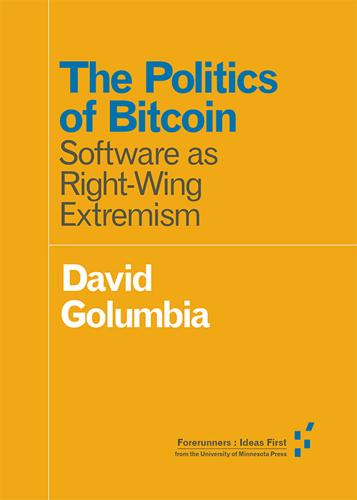
The Politics of Bitcoin: Software as Right-Wing Extremism
by
David Golumbia
Published 25 Sep 2016
In this sense, it becomes a tool for existing power to concentrate itself, rather than a challenge to the existing order: as some better economically informed commentators consistently point out, Bitcoin functions much more like a speculative investment than a currency (Worstall 2013; Yermack 2014), although what one is investing in, beyond Bitcoin itself, is not at all clear. 6. The Future of Bitcoin and the Blockchain BITCOIN IS NOT SO MUCH a single software program as it is software written using a model called the blockchain that is can be used to build other very similar programs (related cryptocurrencies like Litecoin, Dogecoin, and so on), but also less similar ones. The cryptographically enabled distributed ledger, and the blockchain used to implement it, advocates insist, have wide application outside of their current uses.[1] We hear (not infrequently) that the blockchain is as revolutionary today as were “personal computers in 1975, the internet in 1993” (Andreessen 2014).
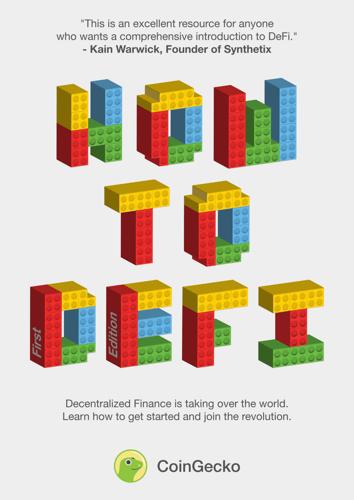
How to DeFi
by
Coingecko
,
Darren Lau
,
Sze Jin Teh
,
Kristian Kho
,
Erina Azmi
,
Tm Lee
and
Bobby Ong
Published 22 Mar 2020
The sETH pool on Uniswap is currently the largest Pool on Uniswap with over 35,000 ETH (~$80mm @ $200 ETH) in liquidity). ~ What Assets do Synths Support? At the point of writing, Synths support the following 4 major asset classes (full list): (i) Cryptocurrencies: Ethereum (ETH), Bitcoin (BTC), Binance Coin (BNB), Tezos (XTZ), Maker (MKR), Tron (TRX), Litecoin (LTC), and Chainlink (LINK) (ii) Commodities: Gold (XAU) and Silver (XAG) (iii) Fiat Currencies: USD, AUD, CHF, JPY, EUR, and GBP (iv) Indexes: CEX and DEFI ~ Index Synths One of the interesting Synths available on Synthetix is the Index Synths. At the time of writing, there are 2 different Index Synths, namely sCEX and sDEFI.
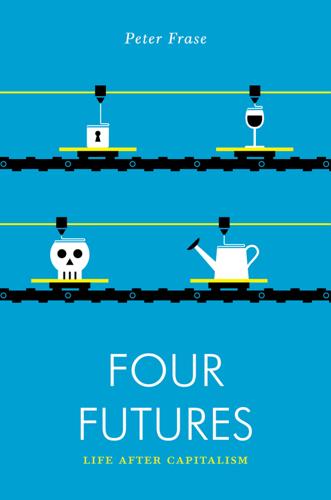
Four Futures: Life After Capitalism
by
Peter Frase
Published 10 Mar 2015
The rediscovery of the need for central banking and government regulation is good for a laugh at the expense of a gaggle of libertarian young men, but it tells us little about the future. Bitcoin is not the only cryptocurrency, however, even though it has the most exchange value in traditional currencies, and has certainly been the most widely promoted. Innumerable rivals exist, based on slight variations of the Bitcoin code, going by names like Litecoin and Quarkcoin. Many of these are opportunistic rivals driven by speculators. They are little better than traditional stock market pump-and-dump scams, in which a few promoters talk up the value of a company so that others will bid up its price, and then sell off their own holdings before the suckers realize what’s happening.
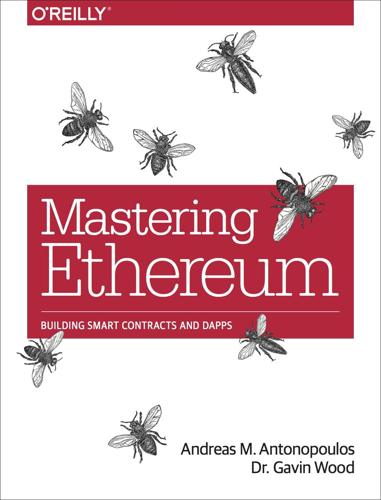
Mastering Ethereum: Building Smart Contracts and DApps
by
Andreas M. Antonopoulos
and
Gavin Wood Ph. D.
Published 23 Dec 2018
In the case of Parity, the light client is marked “experimental” and can be used by running parity with the --light option. Popular mobile wallets include the following (we list these merely as examples; this is not an endorsement or an indication of the security or functionality of these wallets): Jaxx A multicurrency mobile wallet based on BIP-39 mnemonic seeds, with support for Bitcoin, Litecoin, Ethereum, Ethereum Classic, ZCash, a variety of ERC20 tokens, and many other currencies. Jaxx is available on Android and iOS, as a browser plug-in wallet, and as a desktop wallet for a variety of operating systems. Status A mobile wallet and DApp browser, with support for a variety of tokens and popular DApps.
…
Table 5-6 shows a few more examples. Table 5-6. BIP-44 HD wallet structure examples HD path Key described M/44'/60'/0'/0/2 The third receiving public key for the primary Ethereum account M/44'/0'/3'/1/14 The 15th change-address public key for the 4th Bitcoin account m/44'/2'/0'/0/1 The second private key in the Litecoin main account, for signing transactions Conclusions Wallets are the foundation of any user-facing blockchain application. They allow users to manage collections of keys and addresses. Wallets also allow users to demonstrate their ownership of ether, and authorize transactions, by applying digital signatures, as we will see in Chapter 6.
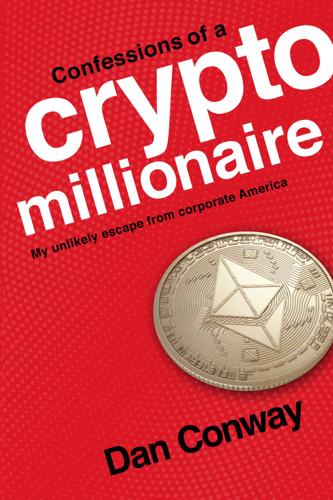
Confessions of a Crypto Millionaire: My Unlikely Escape From Corporate America
by
Dan Conway
Published 8 Sep 2019
That allowed me to say, “Don’t worry, blockchain is going to solve all of that.” He looked up from his papers, grabbed his phone and said, “Well, I have my crypto right here.” That was a damn near perfect assist, a textbook bridge, allowing me to say, “That crypto is how we’re buying this car.” And then, to Eileen’s dismay, we talked crypto. He owned ETH, Litecoin and TRON. I knew that TRON was widely considered a scam. I told him he should look into it. He said, “Yeah, I just bought some because it was only a few cents.” He’s like a lot of noobs who flooded into crypto in 2017, people who don’t understand market cap in relation to the number of coins in circulation, and instead simply hope there is some chance a random coin can rise to twenty thousand dollars, “just like Bitcoin.”
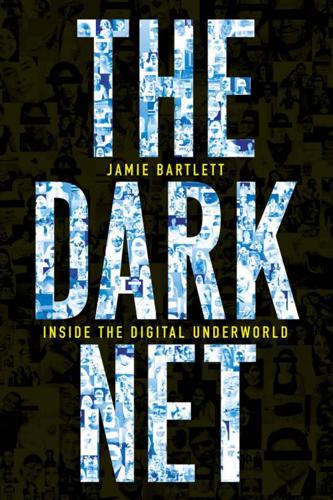
The Dark Net
by
Jamie Bartlett
Published 20 Aug 2014
One hacker posts all the site’s internal information and user information. 2 February: CannabisRoad is hacked. 3 February: Black Goblin Market launches, and a day later is taken down due to amateurish security. First week of February: Utopia marketplace is launched. It has a strong connection to Black Market Reloaded. Early February: The White Rabbit marketplace is set up. It accepts Bitcoins and Litecoins, and runs on I2P, not Tor. 12 February: Dutch police seize Utopia, forcing it offline. They decline to discuss the details. Early February: Silk Road 2.0 is hacked, $2.7 million in Bitcoins lost. 16 February: Agora Market becomes the most popular marketplace on the deep web. Late February/early March: Agora is closed down, reopened and closed numerous times as a result of intensive distributed denial of service attacks.

Unknown Market Wizards: The Best Traders You've Never Heard Of
by
Jack D. Schwager
Published 2 Nov 2020
Our discussion turned to why he decided to get out when he did. Did something change atmosphere-wise when you decided to get out? Yeah. I call it my golf course indicator. I usually never talk markets with my golf buddies. I showed up for the first tee, and this 60-year-old who has never speculated in stocks asked me about Litecoin. To me, that was a clear sign that the masses knew about this trade. By that point, I had been in this trade for over a year. I thought it was time for me to start looking to get out. If you get stopped out of a trade, will you look to reenter it if conditions are right? It’s easy for me to buy it again.
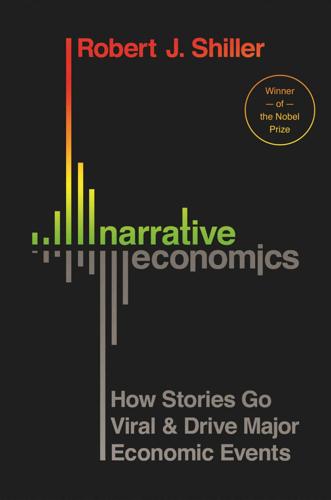
Narrative Economics: How Stories Go Viral and Drive Major Economic Events
by
Robert J. Shiller
Published 14 Oct 2019
Narrative economics, the study of the viral spread of popular narratives that affect economic behavior, can improve our ability to anticipate and prepare for economic events. It can also help us structure economic institutions and policy. To get a feel for where we are going, let’s begin by considering one such popular narrative, recently in full swing. Bitcoin, the first of thousands of privately issued cryptocurrencies—including Litecoin, Ripple, Ethereum, and Libra—has generated enormous levels of talk, enthusiasm, and entrepreneurial activity. These narratives surrounding Bitcoin, the most remarkable cryptocurrency in history as judged by the speculative enthusiasm for it and its market price rather than its actual use in commerce, provide an intuitive basis for discussing the basic epidemiology of narrative economics (which we explore in detail in chapter 3).

Engineering Security
by
Peter Gutmann
Having said that though, the Bitcoin ASICs for which details have been published are specifically designed for high-speed mining rather than passwordcracking, so that they would require significant changes to their control circuitry in order to make them suitable for password cracking — it’s not for nothing that they’re called application-specific ICs)71. Two variations of Bitcoin called Litecoin and Novacoin turn another cryptographic mechanism into collateral damage. In this case it’s scrypt, which was specifically designed to be expensive to implement in custom hardware by accessing data spread across a large amount of memory in a pseudorandom manner, a so-called memoryhard algorithm [87].
…
A side-effect of this Lite/Novacoin mining is that, again, a mechanism designed to protect one type of resource, passwords, is weakened when it’s also used to protect another type of resource, coin scarcity. What’s interesting in these situations is that there’s always been an implicit assumption that, spook conspiracies aside, no-one would bother rolling custom hardware just to crack passwords because there’s always an easier way in than going to that sort of extreme. However if the Bitcoin, Litecoin, Novacoin, and whatever71 In any case your passwords are pretty safe for now since anyone who has an ASIC-based rig is more interested in mining coins than cracking passwords. 312 Design else-coin fans are resorting to custom hardware in order to break schemes that are used to keep passwords safe then it’s now necessary to design password-hashing functions to resist custom-hardware attacks, not because of theoretical devices fielded by secret government agencies but because of actual devices developed for whatevercoin mining.
…
[74] [75] [76] [77] [78] “Re: delegating SSL certificates”, Dirk-Willem van Gulik, posting to the cryptography@metzdowd.com mailing list, message-ID 02120D26-545E4C38-B8CA-AA01D34E471D@webweaving.org, 16 March 2008. “AWS urges developers to scrub GitHub of secret keys”, Munir Kotadia, 24 March 2014, http://www.itnews.com.au/News/375785,aws-urgesdevelopers-to-scrub-github-of-secret-keys.aspx. “My run in with Unauthorised Litecoin mining on AWS”, Luke Chadwick, 16 December 2013, http://vertis.io/2013/12/16/unauthorised-litecoinmining.html. “My $500 Cloud Security Screwup”, Rich Mogull, 7 January 2014, https://securosis.com/blog/my-500-cloud-security-screwup. “Glitch imperils swath of encrypted records”, Shaun Waterman, The Washington Times, 25 December 2012, http://www.washingtontimes.com/news/2012/dec/25/glitch-imperilsswath-of-encrypted-records
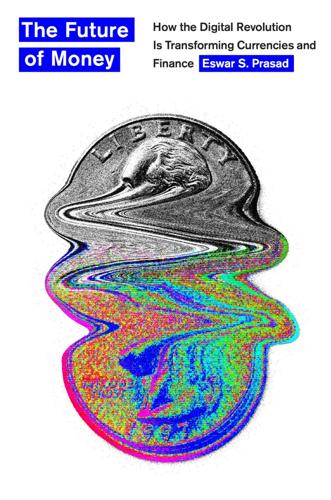
The Future of Money: How the Digital Revolution Is Transforming Currencies and Finance
by
Eswar S. Prasad
Published 27 Sep 2021
Backed by this irresistible pitch, Jesus Coin was issued on the Ethereum platform in late 2017 (the ICO ended on December 25) and briefly hit a market capitalization of about $20 million in February 2018. Sadly, this miracle was not enough to sway the skeptics and naysayers, and the coin expired on the cross. Based on the popular “Doge” internet meme and featuring a Shiba Inu (a Japanese breed of dog) as its mascot, Dogecoin (DOGE) is a cryptocurrency that was forked from Litecoin in December 2013. Dogecoin has been used primarily as a tipping system on Reddit and Twitter to reward the creation or sharing of quality content. Its creators had envisioned it as “a fun, light-hearted cryptocurrency that would have greater appeal beyond the core Bitcoin audience.” From its inception until April 2017, Dogecoin’s market capitalization was under $30 million, already a sizable figure for a whimsical cryptocurrency.

Future Crimes: Everything Is Connected, Everyone Is Vulnerable and What We Can Do About It
by
Marc Goodman
Published 24 Feb 2015
In the days of Al Capone’s Prohibition-era racketeering, the Feds’ mantra became “Follow the money,” and it was ultimately tax evasion charges, not murder convictions, that brought down the world’s biggest crime boss of the 1930s. Though “follow the money” has been the core credo in law enforcement ever since, cops may soon have to find a new motto. There are now more than seventy virtual crypto-currency competitors to Bitcoin, such as Ripple, Litecoin, and Dogecoin, and it is estimated nearly $10 billion in virtual currencies were transacted in 2013 alone. Given the vast sums at play, it should come as no surprise that criminals are not only transacting Bitcoin but also targeting the crypto currency for theft. Hackers have been able to steal millions and millions of dollars in virtual money from one another, with the largest attack to date directed against Mt.